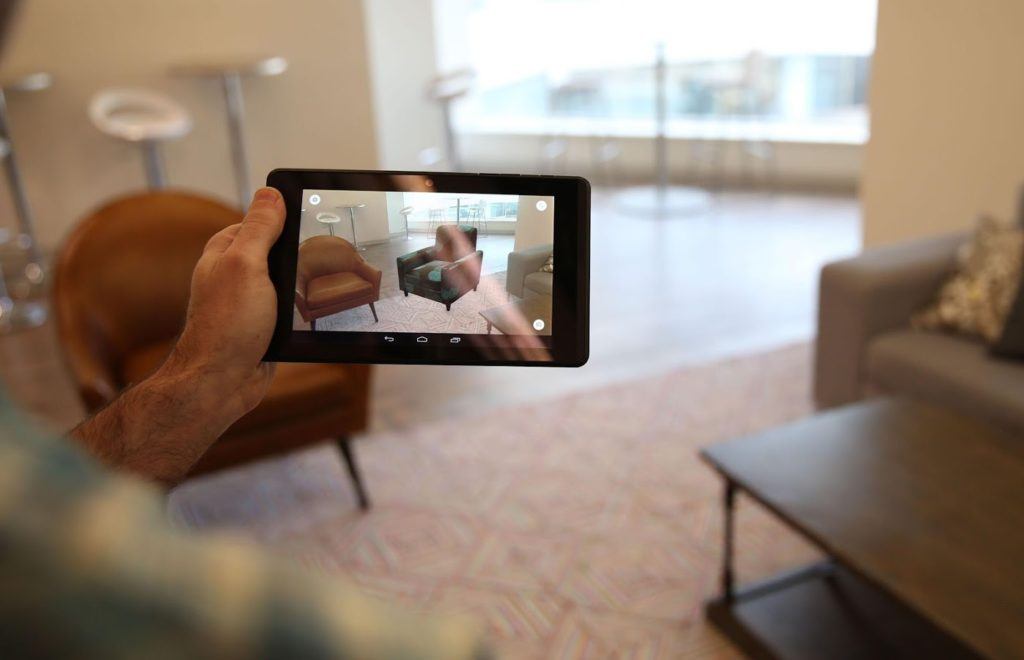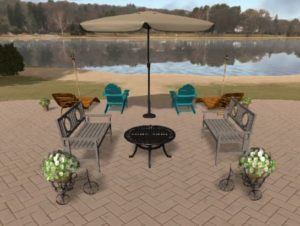If the couch don’t fit, you don’t have to commit

Wayfair is bringing AR and VR technology to your living room to change the way consumers experience online shopping
Buying furniture the traditional way is a uniquely painful experience. Imagine buying a couch. You have to trek to a home goods store, like Ikea or West Elm, wherein you encounter hundreds of sofa options, all of which look great in the store. But will it look good in your living room? Will it even fit (you probably forgot to measure)? How are you going to get it home?
The team behind Wayfair, the Boston-based online retailer, set out to make this process a lot less painful for consumers. Founded in 2002, Wayfair is now the largest pure-play online retailer of home goods, generating over $3B in annual revenue [1] [2]. Boasting over seven million products, Wayfair combines the convenience of online shopping with a guarantee that you find the right piece of furniture at the right price point [3]. Not content with merely disrupting the traditional brick-and-mortar home goods shopping experience, Wayfair is setting its sights on the next frontier of digital technology: bringing AR and VR into (the furnishing of) your living room.
Augmented reality (AR) describes the blending of the real world with digital objects, like Google Glass or Pokémon Go [4). Virtual reality (VR) takes this concept even further, utilizing accessories like the Oculus Rift headset to immerse the user in a wholly digital world [4]. While these concepts may seem on the fringe of mainstream consumer use, Wayfair is investing in both technologies to solidify their position as a leading home goods retailer.
On the AR side, Wayfair recently launched their WayfairView application to allow users to place full-scale 3-D models of products in real settings [5]. Utilizing Lenovo’s new Phab2 Pro tablet running google Tango technology, users can upload photos of their living room that include digital measurements of each object. This enables shoppers to select digital models of Wayfair products and see how the furniture actually fits in their home, and whether it matches their existing décor [5].

Not content with an AR offering, Wayfair has also launched two VR applications this year: Patio Playground and IdeaSpace. Both of these apps allow users to arrange and interact with Wayfair products in different virtual settings. Patio Playground allows users to arrange patio furniture in their backyard, while IdeaSpace aims to inspire customers by letting them experience Wayfair furniture in a variety of virtual room settings [2] [6]. These apps require a user to have access to a VR headset, like Oculus Rift, but offer a new level of immersion into Wayfair’s catalog. So far, Wayfair has created 10,000 3-D models of its furniture products, and hopes to convert their entire catalog of 7-million products into a virtual library within 5 years [7]. This is no small feat considering that each product must be put onto a turntable and rotated around four-high resolution digital cameras (the camerawork takes five-ten minutes per product, plus several hours of post-production processing). [4].


It’s too early to assess the impact that Wayfair’s foray into AR and VR will have on their home goods sales, but these concepts are a natural extension of Wayfair’s business model (transforming the home goods shopping experience from a painful experience to a pleasant affair) and operating model (building a cutting-edge technological platform to connect buyers with products that fit their tastes and needs). These applications support both models: they make shopping online for furniture more appealing to new buyers, and utilize technology to allow Wayfair to better compete with the traditional retailers that let shoppers physically experience a product before they buy. [4].
I’m impressed by Wayfair’s early commitment to these emerging technologies, but I would challenge the company to get these applications in the hands of as many people as possible, in order to accelerate the shift to buying furniture online (online sales make up less than 20% of the total home goods market) [8]. Wayfair has had success partnering with leading tech companies like Google and Oculus – they should think about creating similar partnerships with electronics retailers like Best Buy to promote app demos that allow customers that don’t own the hardware to experience their products. Perhaps they could also deploy roving Wayfair Wayfarers to drive headsets through cities across the country to showcase the Wayfair shopping experience. Finally, Wayfair should think about how to provide more value-added services like design recommendations through AR and VR technology. Speaking as someone with a limited eye for style and design, it would be amazing to upload a photo of my living room and have Wayfair generate a full suite of furniture to optimize the space, which I could then explore through a tablet or headset.
Word count – 771
References
1 “Wayfair.” Crunchbase. https://www.crunchbase.com/organization/wayfair#/entity. Accessed 15 Nov. 2016.
2 “Wayfair Unveils Immersive Home Design Experience with Daydream Virtual Reality App.” Wayfair. 10 Nov. 2016. http://investor.wayfair.com/investor-relations/press-releases/press-releases-details/2016/Wayfair-Unveils-Immersive-Home-Design-Experience-with-Daydream-Virtual-Reality-App/default.aspx. Accessed 15 Nov. 2016.
3 “About Wayfair.” Wayfair. https://www.wayfair.com/about/. Accessed 15 Nov. 2016.
4 Kirsner, Scott. “Adding a level of reality to online shopping.” Boston Globe. 5 May 2016. https://www.bostonglobe.com/business/2016/05/05/adding-level-reality-online-shopping/wXRlzWBdGIo7j5LO8sOg5K/story.html. Accessed 15 Nov. 2016.
5 Woyke, Elizabeth. “How Stores Will Use Augmented Reality to Make You Buy More Stuff.” MIT Technology Review. 17 Jun. 2016. https://www.technologyreview.com/s/601664/how-stores-will-use-augmented-reality-to-make-you-buy-more-stuff/. Accessed 15 Nov. 2016.
6 O’Shea, Dan. “Wayfair expands virtual reality universe with IdeaSpace.” RetailDive. 13 Nov. 2016. http://www.retaildive.com/news/wayfair-expands-virtual-reality-universe-with-ideaspace/430310/. Accessed 15 Nov. 2016.
7 Merrill, Kate. “Boston-Based Company Bringing Virtual Reality to Online Shopping.” CBS Boston. 2 Nov. 2016. http://boston.cbslocal.com/2016/11/02/online-shopping-virtual-reality-wayfair/. Accessed 3 Nov. 2016.
8 Briggs, Bill. “What’s driving home goods purchases online.” Internet Retailer. 15 Jul. 2016. https://www.internetretailer.com/2016/07/15/whats-driving-home-goods-purchases-online. Accessed 15 Nov. 2016.



It is true that people are increasingly purchasing furniture online, but I am concerned about whether Wayfair’s operating model fits its price point. Once one graduates from the Ikea days, furniture can become a significant investment. And as much as we have progressed into a digital purchasing world, for a several thousand dollar investment in living room furniture I believe that people are still going to want to see and feel the furniture that they plan to buy. As such, I am concerned that the exclusively online operating model might not be the best bet for furniture with higher prices. AR/VR technology might be able to help assuage this problem, but I don’t think that it will solve it.
That said, I think that for the lower priced items Wayfair has an excellent business and operating model, and the AR/VR will make it a batter user experience. I like your suggestion about providing interior design recommendations. It would also be beneficial if they could implement a program that allow your to place different pieces of furniture in a mock-up of your own home to better visualize how different pieces would fit together.
Very cool post, Mike! I think you are absolutely right when saying that these AR and VR technologies are a natural extension of Wayfair’s business and operating model and thus helps the company to strengthen their core product offering. Having said that, it remains to be seen how much adoption this kind of technology will really experience among consumers and thus act as a significant driver to sales (which you also pointed out). I can imagine that it must be very expensive to develop these kinds of technological systems including creating and maintaining a 3D database of their entire catalog of ~7 million items. I wonder how management is thinking about weighing these large up-front investment costs against their expectations of actual sales impact and at what point in the future they will decide whether this actually is an economically viable opportunity for them or not. I guess only time can tell. In the meantime, maybe they can also promote more benefits to customers using this type of technology, such as a percentage discount off their purchase if the customer researched beforehand using AR or VR (this could be beneficial to both since I imagine average returns on orders made after using AR/VR are lower than on the average order).
Oh my god this is what I want!! We just bought an apartment and are confused about picking up appropriate furnitures. What’s even worse is that both my partner and I are both out of our home city for a while. We can definitely discuss and order things online. But we’re so afraid of receiving the expensive furnitures but they turn out to be not fitting with our room. So we decided to stop thinking about furnitures until we’re back in town – but with the help of AR VR technology, we can feel more safe and confident again!! The only concern is that Wayfair still needs consumers to sit inside their apartment while picking up furnitures – could people take pictures of their rooms and then also enjoy the AR VR scene by themselves? Also, AR VR facilities are still not very common in people’s daily lives. Would it be better if Wayfair has offline stores for people to experience the service?
Interesting post Mike! As a Wayfair customer, I’m surprised I hadn’t heard about any of these options. To that end, I agree with your recommendation that Wayfair should try to increase awareness and adoption of these features as soon as possible. For me, the greatest part of the value proposition is assessing whether the furniture can actually fit in the room instead of using the app to determine if the fabric or design matches the aesthetic of the room. One consideration I have is whether this puts any burden on Wayfair’s retail partners or whether Wayfair alone is taking on all the heavy lifting of ensuring the products featured on the site can be deployed in this application.
Really interesting post Mike! Given that this year was the first time that I had to buy furniture, I would have really appreciated the options that Wayfair is developing. Having said that, I find it really risky to invest heavily on an option that requires customers to have a VR headset, as it would imply a big barrier until the technology is accessible enough, which seems to still be far away. In addition, I would worry that going forward the cost related to the inclusion of each product into the virtual library may be too high, and hence economically unviable. Perhaps, the company could focus on the short term in improving the WayfairView App, and make it a central part of their business and operations.
As an AR evangelist I think your post does a great job of helping us imagine some real-world applications of Augmented Reality. AR is hard – it requires the creation of rich 3-D content, it needs a clear line of sight to a marker onto which it projects the digital image, and it requires significant AR infrastructure to reach scale. Retailers and apparel makers will have plenty of AR applications (e.g. “virtual try-on” services), but I worry that the state of the technology is too premature for Wayfair to reap anything but some reputational benefits from their project.
Further – have you considered how mixed reality (MR), the likes of which is being developed by Magic Leap as we speak, could enrich the e-commerce experience here? There remains the adoption challenge before any of this reaches scale, but the ability to more realistically interact with digital objects in the real world (e.g. physical-digital obstruction) could aid the virtual showroom application that Wayfair is attempting to build.